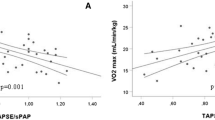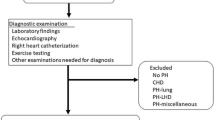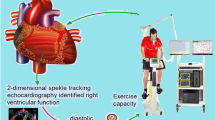Abstract
Purpose
To evaluate the estimated pulmonary arterial systolic pressure (PASP) through transthoracic echocardiography in hemodialysis (HD) patients and associate it with cardiorespiratory fitness and pulmonary function.
Methods
This study was a cross-sectional analysis of HD patients that performed evaluations of cardiac function, cardiorespiratory fitness, and pulmonary function, through transthoracic echocardiography, cardiopulmonary exercise test, spirometry, and manovacuometry, respectively. All patients underwent the evaluations on a non-dialysis day.
Results
Thirty-five HD patients were evaluated and separated according to the presence of probable pulmonary hypertension (PH) (estimated PASP ≥ 35 mmHg) or not (estimated PASP < 35 mmHg). Those HD patients with probable PH had the worst cardiorespiratory fitness, evaluated by the peak oxygen consumption (VO2peak) (17.11 ± 4.40 versus 12.90 ± 2.73 mL/kg/min; p = 0.011), and pulmonary function, evaluated by absolute and predicted of forced vital capacity (FVC) (85.52 ± 12.29 versus 71.38 ± 11.63%; p = 0.005) and absolute and predicted of forced expiratory volume in the first second (FEV1) (83.37 ± 14.98 versus 69.21 ± 13.48%; p = 0.017). The secondary analysis showed that estimated PASP was correlated with VO2peak (r = − 0.508; p = 0.002), FVC (r = − 0.450; p = 0.007), and FEV1 (r = − 0.361; p = 0.033). Moreover, the adjusted odds ratio by HD vintage, dry weight and gender showed that increments in VO2peak (OR 1.62; CI 95% 1.04–2.54; p = 0.034), FVC (OR 39.67; CI 95% 1.74–902.80; p = 0.021), and FEV1 (OR 39.54; CI 95% 1.89–826.99; p = 0.018) were associated with 1-fold and 39-fold higher chance, respectively, for not having PH. However, all these associations were lost when age was included in the analysis.
Conclusions
The HD patients with probable PH had the worst cardiorespiratory fitness and pulmonary function. Exploratory analyses showed that greater cardiopulmonary fitness was associated with better cardiac function. Moreover, increments in cardiorespiratory fitness and pulmonary function may increase the chance of not having PH.

Similar content being viewed by others
Data availability
Not applicable.
Code availability
Not applicable.
References
Rroji M, Cafka M, Seferi S, Seiti J, Barbullushi M, Goda A (2021) The potential effect of cardiac function on pulmonary hypertension, other risk factors, and its impact on survival in dialysis patients. Int Urol Nephrol 53:343–351. https://doi.org/10.1007/s11255-020-02655-z
Schoenberg NC, Argula RG, Klings ES, Wilson KC, Farber HW (2020) Prevalence and mortality of pulmonary hypertension in ESRD: a systematic review and meta-analysis. Lung 198:535–545. https://doi.org/10.1007/s00408-020-00355-0
Agarwal R (2012) Prevalence, determinants and prognosis of pulmonary hypertension among hemodialysis patients. Nephrol Dial Transplant 27:3908–3914. https://doi.org/10.1093/ndt/gfr661
Berger M, Haimowitz A, Van Tosh A, Berdoff RL, Goldberg E (1985) Quantitative assessment of pulmonary hypertension in patients with tricuspid regurgitation using continuous wave Doppler ultrasound. J Am Coll Cardiol 6:359–365. https://doi.org/10.1016/S0735-1097(85)80172-8
Silva CES, Tasca R, Weitzel LH, Moisés VA, Ferreira LDC, Tavares GMP, Pena JLB, Ortiz J, Medeiros CCJ, Monaco CG, Peixoto LB, Guimarães JI (2004) Normatização dos Equipamentos e Técnicas de Exame para Realização de Exames Ecocardiográficos. Arq Bras Cardiol 82:1–10. https://doi.org/10.1590/S0066-782X2004000800001
Yigla M, Nakhoul F, Sabag A, Tov N, Gorevich B, Abassi Z, Reisner SA (2003) Pulmonary hypertension in patients with end-stage renal disease. Chest 123:1577–1582. https://doi.org/10.1378/chest.123.5.1577
Currie PJ, Seward JB, Chan KL, Fyfe DA, Hagler DJ, Mair DD, Reeder GS, Nishimura RA, Tajik AJ (1985) Continuous wave doppler determination of right ventricular pressure: a simultaneous doppler-catheterization study in 127 patients. J Am Coll Cardiol 6:750–756. https://doi.org/10.1016/S0735-1097(85)80477-0
Tang M, Batty JA, Lin C, Fan X, Chan KE, Kalim S (2018) Pulmonary hypertension, mortality, and cardiovascular disease in CKD and ESRD patients: a systematic review and meta-analysis. Am J Kidney Dis 72:75–83. https://doi.org/10.1053/j.ajkd.2017.11.018
Yilmaz S, Yildirim Y, Taylan M, Demir M, Yilmaz Z, Kara AV, Aydin F, Sen HS, Karabulut A, Topcu F (2016) The relationship of fluid overload as assessed by bioelectrical impedance analysis with pulmonary arterial hypertension in hemodialysis patients. Med Sci Monit 22:488–494. https://doi.org/10.12659/MSM.896305
Yılmaz S, Yildirim Y, Yilmaz Z, Kara AV, Taylan M, Demir M, Coskunsel M, Kadiroglu AK, Yilmaz ME (2016) Pulmonary function in patients with end-stage renal disease: effects of hemodialysis and fluid overload. Med Sci Monit 22:2779–2784. https://doi.org/10.12659/MSM.897480
Lim K, McGregor G, Coggan AR, Lewis GD, Moe SM (2020) Cardiovascular functional changes in chronic kidney disease: integrative physiology, pathophysiology and applications of cardiopulmonary exercise testing. Front Physiol 11:1–14. https://doi.org/10.3389/fphys.2020.572355
Andrade FP, Borba GC, Silva KC, de Ferreira TS, Oliveira SG, Antunes VVH, Veronese FV, Rovedder PME (2022) Intradialytic periodized exercise improves cardiopulmonary fitness and respiratory function: a randomized controlled trial. Semin Dial 35:181–189. https://doi.org/10.1111/sdi.13020
ATS/ACCP Statement on Cardiopulmonary Exercise Testing (2003) Am J Respir Crit Care Med 167:211–277. https://doi.org/10.1164/rccm.167.2.211
Borg GA (1982) Psychophysical bases of perceived exertion. Med Sci Sports Exerc 14:377–381
Graham BL, Steenbruggen I, Miller MR, Barjaktarevic IZ, Cooper BG, Hall GL, Hallstrand TS, Kaminsky DA, McCarthy K, McCormack MC, Oropez CE, Rosenfeld M, Stanojevic S, Swanney MP, Thompson BR (2019) Standardization of spirometry 2019 update an official american thoracic society and European respiratory society technical statement. Am J Respir Crit Care Med 200:e70–e88. https://doi.org/10.1164/rccm.201908-1590ST
Neder JA, Andreoni S, Lerario MC, Nery LE (1999) Reference values for lung function tests: II maximal respiratory pressures and voluntary ventilation. Brazilian J Med Biol Res 32:719–727. https://doi.org/10.1590/S0100-879X1999000600007
MM M (2012) A guide to appropriate use of correlation coefficient in medical research. Malawi Med J 24:69–71
He Y, Wang Y, Luo X, Ke J, Du Y, Li M (2015) Risk factors for pulmonary hypertension in maintenance hemodialysis patients: a cross-sectional study. Int Urol Nephrol 47:1889–1897. https://doi.org/10.1007/s11255-015-1119-5
Ramasubbu K, Deswal A, Herdejurgen C, Aguilar D, Frost AE (2011) A prospective echocardiographic evaluation of pulmonary hypertension in chronic hemodialysis patients in the United States: prevalence and clinical significance. Am J Clin Hypn 53:279–286. https://doi.org/10.2147/IJGM.S12946
Najafian J, Taheri S, Mahaki B, Molavi S, Alami S, Khalesi S, Salehi A (2015) Comparing right ventricular function and pulmonary artery pressure before and shortly after hemodialysis in patients with end-stage renal disease. Adv Biomed Res 4:197–197. https://doi.org/10.4103/2277-9175.166133
Loutradis C, Sarafidis PA, Papadopoulos CE, Papagianni A, Zoccali C (2018) The Ebb and flow of echocardiographic cardiac function parameters in relationship to hemodialysis treatment in patients with ESRD. J Am Soc Nephrol 29:1372–1381. https://doi.org/10.1681/ASN.2017101102
Karacan O, Tutal E, Colak T, Sezer S, Eyüboğlu FO, Haberal M (2006) Pulmonary function in renal transplant recipients and end-stage renal disease patients undergoing maintenance dialysis. Transpl Proc 38:396–400. https://doi.org/10.1016/j.transproceed.2005.12.068
Kirkman DL, Muth BJ, Stock JM, Townsend RR, Edwards DG (2018) Cardiopulmonary exercise testing reveals subclinical abnormalities in chronic kidney disease. Eur J Prev Cardiol 25:1717–1724. https://doi.org/10.1177/2047487318777777
Bullock RE, Amer HA, Simpson I, Ward MK, Hall RJ (1984) Cardiac abnormalities and exercise tolerance in patients receiving renal replacement therapy. BMJ 289:1479–1484. https://doi.org/10.1136/bmj.289.6457.1479
Momeni A, Nematolahi A, Nasr M (2014) Effect of intradialytic exercise on echocardiographic findings in hemodialysis patients. Iran J Kidney Dis 8:207–211
Kouidi EJ, Grekas DM, Deligiannis AP (2009) Effects of exercise training on noninvasive cardiac measures in patients undergoing long-term hemodialysis: a randomized controlled trial. Am J Kidney Dis 54:511–521. https://doi.org/10.1053/j.ajkd.2009.03.009
Acknowledgements
We appreciate the funding organizations Coordenação de Aperfeiçoamento de Pessoal de Nível Superior (CAPES) and Hospital de Clínicas de Porto Alegre—Research Incentive Fund (FIPE).
Funding
The authors disclosed receipt of the following financial support for the publication of this article: Hospital de Clínicas de Porto Alegre—Research Incentive Fund (FIPE) [grant number 2015-0151] and Coordenação de Aperfeiçoamento de Pessoal de Nível Superior.
Author information
Authors and Affiliations
Contributions
All the authors contributed to the study conception and design. Material preparation, data collection, and analysis were performed by FPA and GCB. The first draft of the manuscript was written by FPA and GCB, and all the authors commented on previous versions of the manuscript. All the authors have read and approved the final version.
Corresponding author
Ethics declarations
Conflict of interest
The authors declare no conflict of interest.
Ethical approval
This study was approved by the Ethics and Research Committee of Hospital de Clínicas de Porto Alegre, under number CAAE 40167014.3.0000.5327.
Consent to participate
Informed consent was obtained from all individual participants included in the study.
Consent for publication
All the authors agreed with the content and gave explicit consent to submit, and obtained consent from the responsible authorities at the organization where the work has been carried out, before the work is submitted.
Additional information
Publisher's Note
Springer Nature remains neutral with regard to jurisdictional claims in published maps and institutional affiliations.
Rights and permissions
Springer Nature or its licensor holds exclusive rights to this article under a publishing agreement with the author(s) or other rightsholder(s); author self-archiving of the accepted manuscript version of this article is solely governed by the terms of such publishing agreement and applicable law.
About this article
Cite this article
Borba, G.C., Andrade, F.P., de Souza Ferreira, T. et al. Estimation of pulmonary artery systolic pressure in hemodialysis patients and its association with cardiorespiratory fitness and pulmonary function. Int Urol Nephrol 55, 961–968 (2023). https://doi.org/10.1007/s11255-022-03381-4
Received:
Accepted:
Published:
Issue Date:
DOI: https://doi.org/10.1007/s11255-022-03381-4




